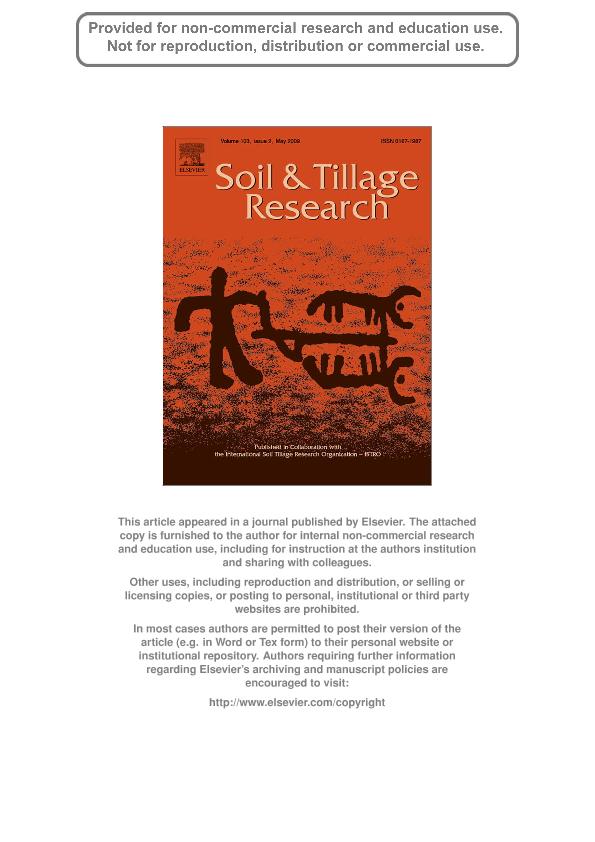Mostrar el registro sencillo del ítem
dc.contributor.author
Meriles, Jose Manuel

dc.contributor.author
Vargas Gil, Silvina

dc.contributor.author
Conforto, Cinthia
dc.contributor.author
Figoni, Gervasio
dc.contributor.author
Lovera, Edgar
dc.contributor.author
March, Guillermo Juan

dc.contributor.author
Guzman, Carlos Alberto

dc.date.available
2017-10-09T19:49:35Z
dc.date.issued
2009-05
dc.identifier.citation
Meriles, Jose Manuel; Vargas Gil, Silvina; Conforto, Cinthia; Figoni, Gervasio; Lovera, Edgar; et al.; Soil microbial communities under different soybean cropping systems: characterization of microbial population dynamics, soil microbial activity, microbial biomass, and fatty acid profiles; Elsevier Science; Soil & Tillage Research; 103; 2; 5-2009; 271-281
dc.identifier.issn
0167-1987
dc.identifier.uri
http://hdl.handle.net/11336/26259
dc.description.abstract
This work analyzes the direct effect of soil management practices on soil microbial communities, which may affect soil productivity and sustainability. The experimental design consisted of two tillage treatments: reduced tillage (RT) and zero tillage (ZT), and three crop rotation treatments: continuous soybean (SS), corn–soybean (CS), and soybean–corn (SC). Soil samples were taken at soybean planting and harvest. The following quantifications were performed: soil microbial populations by soil dilution plate technique on selective and semi-selective culture media; microbial respiration and microbial biomass by chloroform fumigation-extraction; microbial activity by fluorescein diacetate hydrolysis; and fatty acid methyl ester (FAME) profiles. Soil chemical parameters were also quantified. Soil organic matter content was significantly lower in RT and SS sequence crops, whereas soil pH and total N were significantly higher in CS and SC sequence crops. Trichoderma and Gliocladium populations were lower under RTSS and ZTSS treatments. Except in a few cases, soil microbial respiration, biomass and activity were higher under zero tillage than under reduced tillage, both at planting and harvest sampling times. Multivariate analyses of FAMEs clearly separated both RT and ZT management practices at each sampling time; however, separation of sequence crops was less evident. In our experiments ZT treatment had highest proportion of 10Me 16:0, an actinomycetes biomarker, and 16:1ω9 and 18:1ω7, two fatty acids associated with organic matter content and substrate availability. In contrast, RT treatment had highest content of branched biomarkers (i15:0 and i16:0) and of cy19:0, fatty acids associated with cell stasis and/or stress. As cultural practices can influence soil microbial populations, it is important to analyze the effect that they produce on biological parameters, with the aim of conserving soil richness over time. Thus, in a soybean-based cropping system, appropriate crop management is necessary for a sustainable productivity without reducing soil quality.
dc.format
application/pdf
dc.language.iso
eng
dc.publisher
Elsevier Science

dc.rights
info:eu-repo/semantics/openAccess
dc.rights.uri
https://creativecommons.org/licenses/by-nc-sa/2.5/ar/
dc.subject
Soil Microflora
dc.subject
Fungi
dc.subject
Bacteria
dc.subject
Soybean Management
dc.subject
Microbial Diversity
dc.subject
Cropping System
dc.subject.classification
Otras Agricultura, Silvicultura y Pesca

dc.subject.classification
Agricultura, Silvicultura y Pesca

dc.subject.classification
CIENCIAS AGRÍCOLAS

dc.title
Soil microbial communities under different soybean cropping systems: characterization of microbial population dynamics, soil microbial activity, microbial biomass, and fatty acid profiles
dc.type
info:eu-repo/semantics/article
dc.type
info:ar-repo/semantics/artículo
dc.type
info:eu-repo/semantics/publishedVersion
dc.date.updated
2017-09-15T20:06:41Z
dc.journal.volume
103
dc.journal.number
2
dc.journal.pagination
271-281
dc.journal.pais
Países Bajos

dc.journal.ciudad
Amsterdam
dc.description.fil
Fil: Meriles, Jose Manuel. Consejo Nacional de Investigaciones Científicas y Técnicas. Centro Científico Tecnológico Conicet - Córdoba. Instituto de Ciencia y Tecnología de Alimentos Córdoba. Universidad Nacional de Córdoba. Facultad de Ciencias Químicas. Instituto de Ciencia y Tecnología de Alimentos Córdoba; Argentina
dc.description.fil
Fil: Vargas Gil, Silvina. Instituto Nacional de Tecnología Agropecuaria. Centro de Investigación En Ciencias Veterinarias y Agronomicas. Instituto de Fitopatología y Fisiología Vegetal; Argentina. Consejo Nacional de Investigaciones Científicas y Técnicas; Argentina
dc.description.fil
Fil: Conforto, Cinthia. Instituto Nacional de Tecnología Agropecuaria. Centro de Investigación En Ciencias Veterinarias y Agronomicas. Instituto de Fitopatología y Fisiología Vegetal; Argentina
dc.description.fil
Fil: Figoni, Gervasio. Instituto Nacional de Tecnología Agropecuaria. Centro de Investigación En Ciencias Veterinarias y Agronomicas. Instituto de Fitopatología y Fisiología Vegetal; Argentina
dc.description.fil
Fil: Lovera, Edgar. Instituto Nacional de Tecnología Agropecuaria. Centro Regional Córdoba. Estación Experimental Agropecuaria Manfredi; Argentina
dc.description.fil
Fil: March, Guillermo Juan. Instituto Nacional de Tecnología Agropecuaria. Centro de Investigación En Ciencias Veterinarias y Agronomicas. Instituto de Fitopatología y Fisiología Vegetal; Argentina
dc.description.fil
Fil: Guzman, Carlos Alberto. Consejo Nacional de Investigaciones Científicas y Técnicas. Centro Científico Tecnológico Conicet - Córdoba. Instituto de Ciencia y Tecnología de Alimentos Córdoba. Universidad Nacional de Córdoba. Facultad de Ciencias Químicas. Instituto de Ciencia y Tecnología de Alimentos Córdoba; Argentina
dc.journal.title
Soil & Tillage Research

dc.relation.alternativeid
info:eu-repo/semantics/altIdentifier/url/http://www.sciencedirect.com/science/article/pii/S0167198708001931
dc.relation.alternativeid
info:eu-repo/semantics/altIdentifier/doi/http://dx.doi.org/10.1016/j.still.2008.10.008
Archivos asociados
